蓝桥杯嵌入式第十三届客观题解析
Posted 花落已飘
tags:
篇首语:本文由小常识网(cha138.com)小编为大家整理,主要介绍了蓝桥杯嵌入式第十三届客观题解析相关的知识,希望对你有一定的参考价值。
文章目录
前言
本篇文章将带大家来学习蓝桥杯嵌入式的客观题了,蓝桥杯嵌入式的客观题涉及到模电,数电,单片机等知识,需要非常扎实的基础,客观题不能急于求成只能脚踏实地一步步的积累,下面就让我们正式进入客观题的讲解。
一、题目1
第一题是一个多选题选ABC

在参考手册中我们可以清楚的看到MCO的输出时钟源,这里并没有HSE/2故选择ABC。
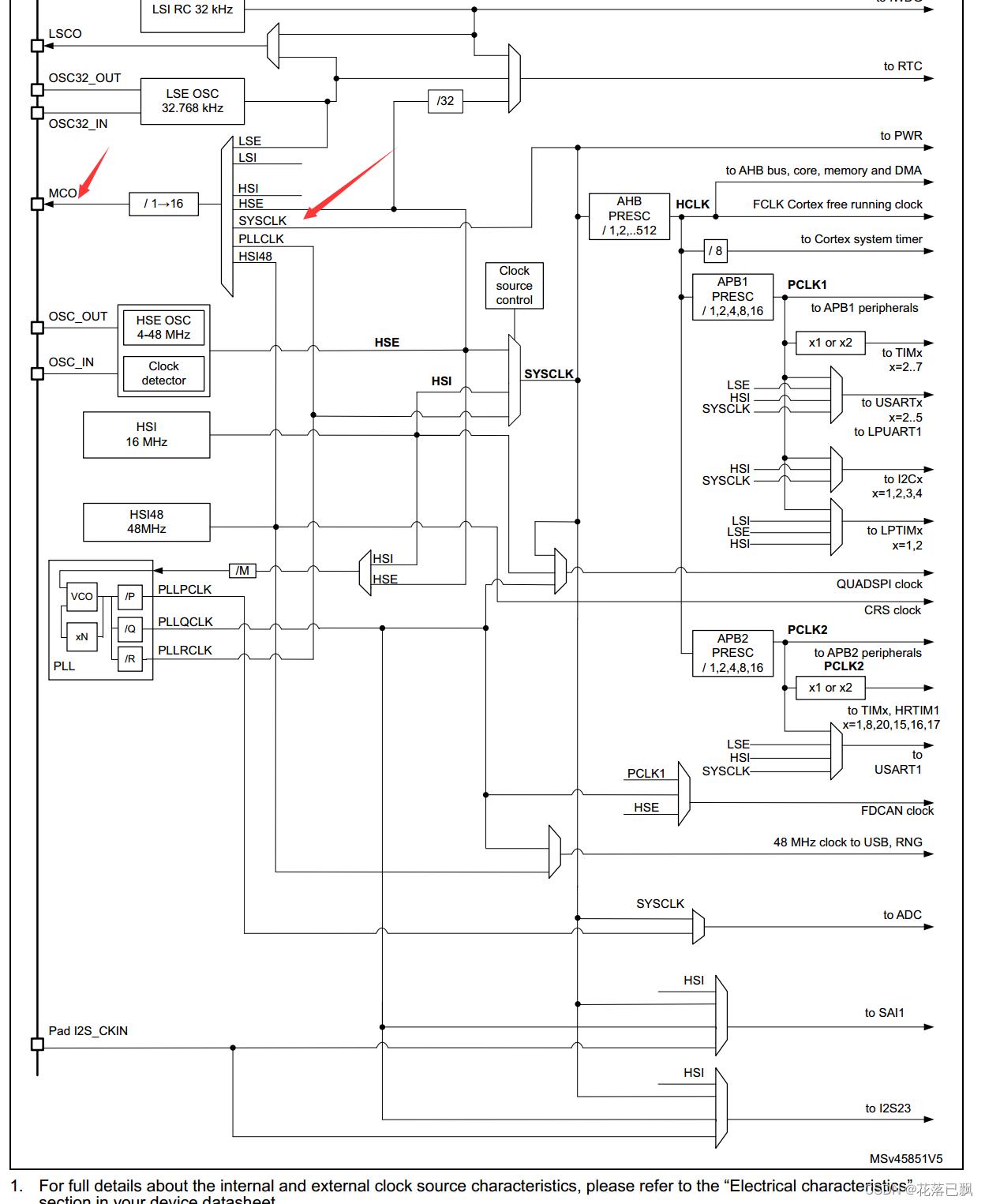
二、题目2
第十三届蓝桥杯省赛 JAVA B组(真题解析+个人体会)(已更新完G题)
试题 A: 星期计算【填空题】
题目:
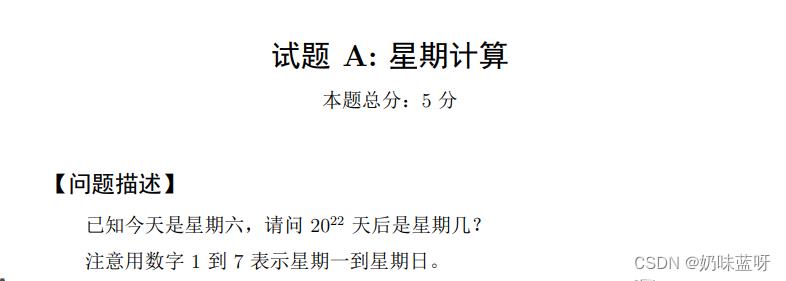
答案:7
解析:
此题直接对7求余即可。
public class Main
public static void main(String[] args)
System.out.println(Math.pow(20, 22) % 7 + 6);
贴一个BigInteger的代码
import java.math.BigInteger;
public class Main
public static void main(String[] args)
BigInteger bg = new BigInteger(20+"");
BigInteger res = bg.pow(22).remainder(BigInteger.valueOf(7)).add(BigInteger.valueOf(6));
System.out.println(res);
试题 B:【填空题】
题目:
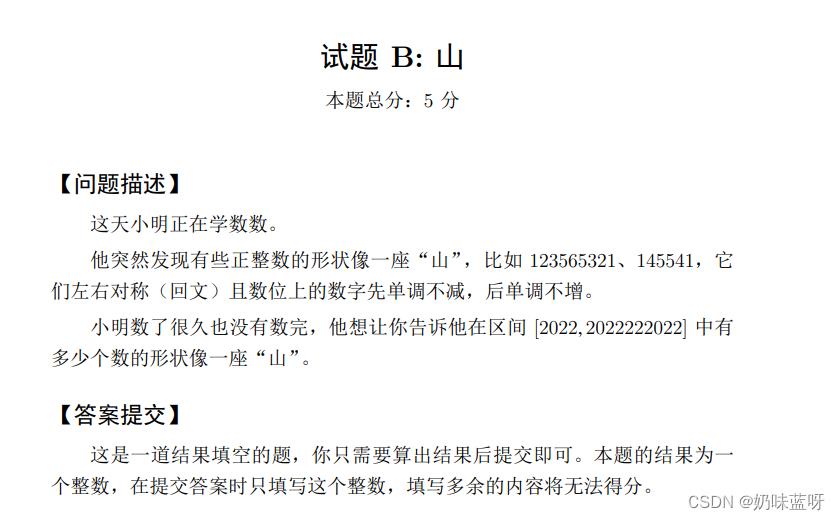
答案:3138
这题我知道很多人把题目都给看错了,我认识好几个都是只看到了回文,没看到还有单调的条件。(大佬们都忙着做后面的题)
解析:
读题可以知道,回文数左右对称,所以只需判断是否回文,然后再判断左边的数单调不减,则右边的数一定单调不增。判断回文数可以使用双指针判断。
public class Main
public static void main(String[] args)
long start = System.currentTimeMillis();
int count = 0;
for (int i = 2022; i <= 2022222022; i++)
if (isPalindrome(i) && check(i))
count++;
long end = System.currentTimeMillis();
System.out.println(count);
System.out.println("共用时" + (end - start) / 1000 % 60 + "秒");//测了一下时间用时40s
private static boolean check(int num)
String s = num + "";
for (int i = 0; i < s.length() / 2; i++)
if (s.charAt(i) > s.charAt(i + 1)) return false;
return true;
private static boolean isPalindrome(int num)
String s = num + "";
int n = s.length() - 1;
for (int l = 0, r = n; l < r; l++, r --)
if (s.charAt(l) != s.charAt(r)) return false;
return true;
试题 C:字符统计【编程题】
题目:
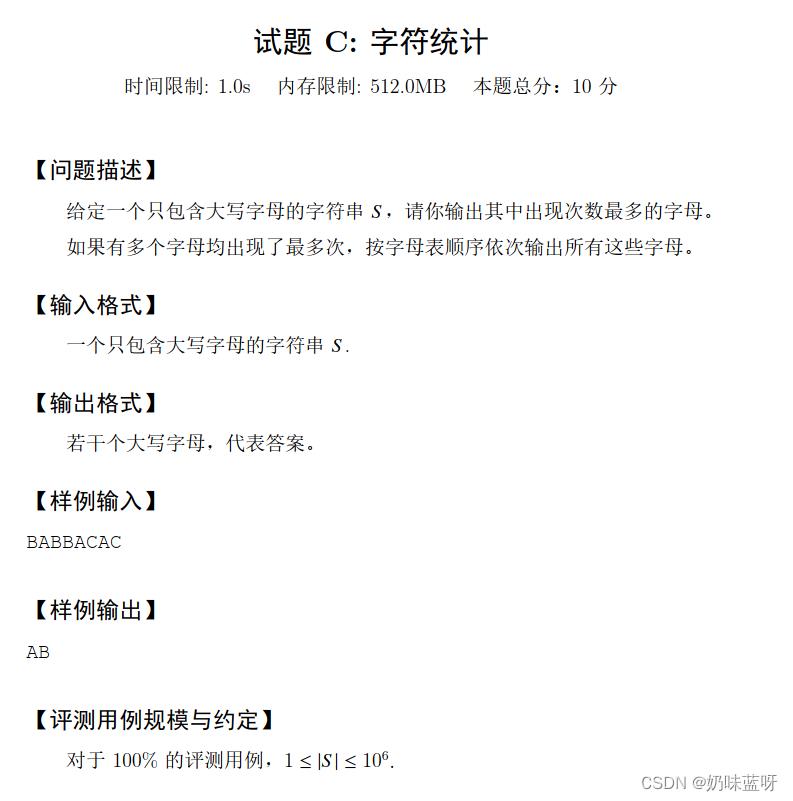
解析:
签到题,分别统计输出即可。
import java.util.Scanner;
public class Main
public static void main(String[] args)
Scanner sc = new Scanner(System.in);
String s = sc.nextLine();
int[] arr = new int[26];
for (int i = 0; i < s.length(); i++)
arr[s.charAt(i) - 'A']++;
int max = Integer.MIN_VALUE;
for (int i = 0; i < 26; i++)
max = Math.max(max, arr[i]);
for (int i = 0; i < 26; i++)
if(arr[i] == max) System.out.print((char) (i+'A'));
试题 D:最少刷题数【编程题】
题目:

解析:
这个题我觉得虽然是个十分题,但是还是挺难的(也可能是我太菜了)。主要是要考虑的因素比较多,核心的想法应该是要计算出左边、右边与中间相等的数的个数,分情况判断每个数加上最小刷题数与中间数相等后需不需要+1。
这题当时给我做烦了,浪费了很多时间,我只考虑了和中间的相比,比它大就输出0,比它小就输出中间的数减去num[i]+1,并没有判断左右数与中间数相等的情况,没有全部AC。这里贴一下别人的代码
import java.util.Arrays;
import java.util.Scanner;
public class Main
public static void main(String[] args)
Scanner sc = new Scanner(System.in);
int n = sc.nextInt();
int[] nums = new int[n];
int[] temp = new int[n];
for (int i = 0; i < n; i++)
nums[i] = sc.nextInt();
temp[i] = nums[i];
// 排序数组
Arrays.sort(temp);
// 中间的下标
int midIndex = n / 2;
// 中间的值
int midValue = temp[midIndex];
int midOption = 0;
int option = 0;
// 左边和中值相同值的数量
int sameLeft = 0;
// 右边和中值相同值的数量
int sameRight = 0;
for (int i = midIndex - 1, j = midIndex; i >= 0; i--, j++)
if (temp[i] == midValue)
sameLeft++;
if (temp[j] == midValue)
sameRight++;
if (temp[i] != temp[j])
break;
if (sameLeft >= sameRight)
option = 1;
if (sameLeft > sameRight)
midOption = 1;
for (int i = 0, len = nums.length; i < len; i++)
int count = 0;
if (nums[i] == midValue)
count = midOption;
else
count = midValue - nums[i] + option;
if (count < 0)
count = 0;
if (i != n - 1)
System.out.print(count + " ");
else
System.out.println(count);
我觉得这个代码的方法还是比较巧妙的hh
-------------------------------------------------------------分界线-----------------------------------------------------------
2023年2月7日更新
核心思想:排序找中位数,然后统计左右两边比mid大和比mid小的数,分类讨论。
(感觉像个模拟题)挺烦的十分题
import java.util.Arrays;
import java.util.Scanner;
public class Main
public static void main(String[] args)
Scanner sc = new Scanner(System.in);
int n = sc.nextInt();
int[] a = new int[n], tmp = new int[n];
for (int i = 0; i < n; i++)
a[i] = sc.nextInt();
tmp[i] = a[i];
Arrays.sort(tmp);
int mid = tmp[n / 2];
int bg_cnt = 0, sml_cnt = 0; // 记录比mid大的和比mid小的数
for (int i = 0; i < n; i++)
if (a[i] < mid) sml_cnt ++;
else if (a[i] > mid) bg_cnt ++;
if (bg_cnt < sml_cnt)
for (int i = 0; i < n; i++)
if (a[i] < mid) System.out.print(mid - a[i] + " ");
else System.out.print(0 + " ");
else if (bg_cnt == sml_cnt)
for (int i = 0; i < n; i++)
if (a[i] < mid) System.out.print(mid - a[i] + 1 + " ");
else System.out.print(0 + " ");
else
for (int i = 0; i < n; i++)
if (a[i] <= mid) System.out.print(mid - a[i] + 1 + " ");
else System.out.print(0 + " ");
试题 E: 求阶乘
题目: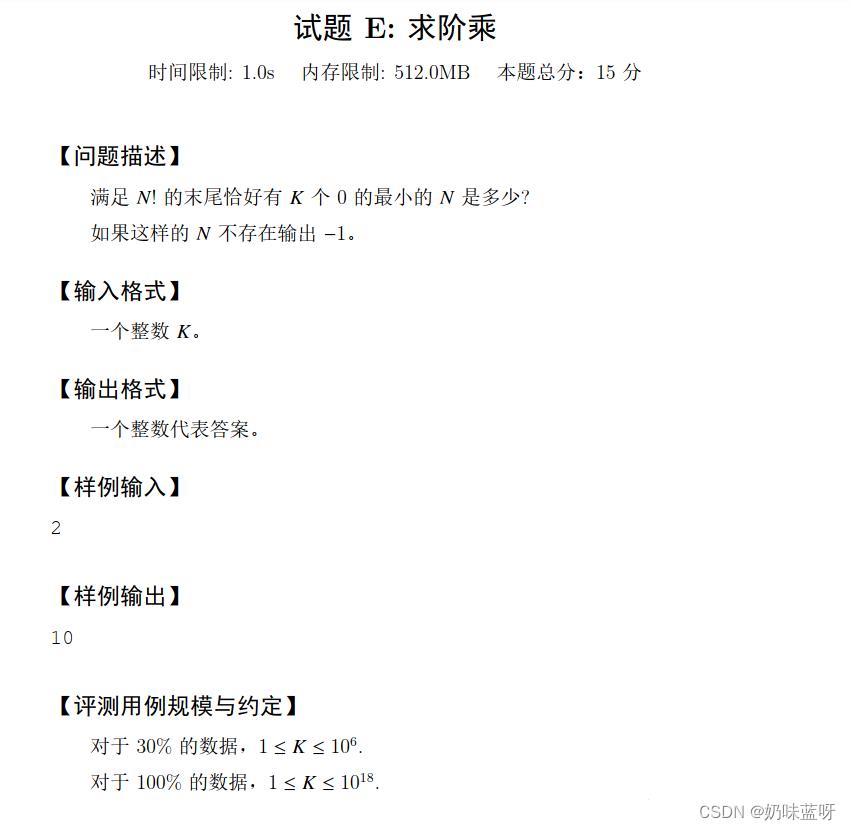
解析
这题我又给想简单了,此题的数据范围非常大,所以可能只能过极个别样例。也不能直接从1到N枚举判断,突破口是数字中谁和谁相乘得到10,很容易想到2*5,2的个数肯定比5多,所以N的阶乘最后有多少0 就看N能分成多少5 。可以从1~N每个数都除以5,然后统计个5的个数,因为25/5也会得到5,所以需要用循环计算。
暴力法
import java.util.Scanner;
public class Main
//后面以0 结尾的一定是5!....(5的倍数的阶乘) 所以只需要判断5的倍数的阶乘
//(判断的数)/5 就是含有5的个数 也是阶乘后0的个数
public static void main(String[] args)
Scanner sc = new Scanner(System.in);
long k = sc.nextLong();
long count;
long a = 5;//直接从5的阶乘(120)开始判断
while (true)
long tempA = a;
count = 0;
while (tempA > 0)
tempA /= 5;
count += tempA;
if (count < k)
a += 5;
else if (count == k)
System.out.println(a);
break;
else
System.out.println(-1);
break;
-------------------------------------------------------------分界线-----------------------------------------------------------
2023年2月8日更新
二分
N 越大,末尾的 0 越多,具有单调性,可以使用二分找到答案。
import java.util.Scanner;
public class Main
// 找N里面有多少个5(25里有两个5) 二分出一个>=k(找大于等于k的第一个位置)的最小的N,不存在则输出-1
public static void main(String[] args)
Scanner sc = new Scanner(System.in);
long l = 1, r = Long.MAX_VALUE-5;
long k = sc.nextLong();
while (l < r)
long mid = l + r >> 1;
if (cal(mid) >= k) r = mid;
else l = mid + 1;
if (cal(r) == k) System.out.println(r);
else System.out.println(-1);
private static long cal(long num)
long cnt = 0;
while (num > 0)
cnt += num / 5;
num /= 5;
return cnt;
试题 F: 最大子矩阵
题目:

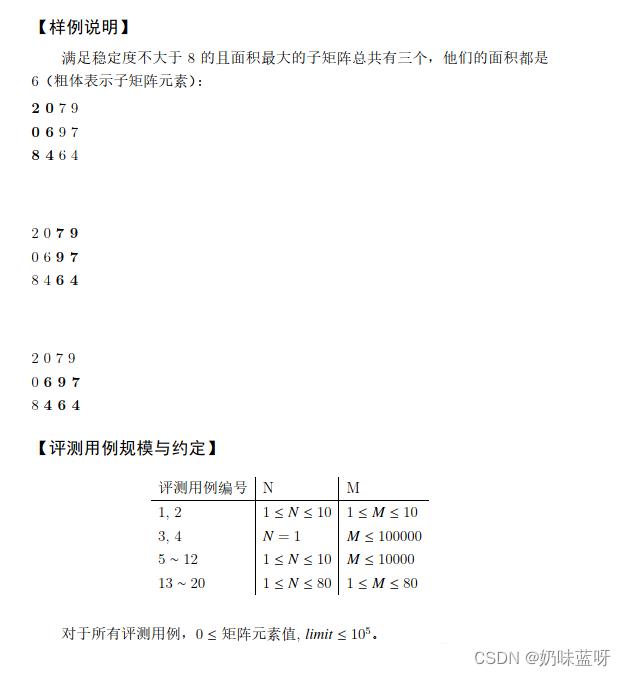
解析:单调队列+二分
这题感觉比G题还难做,考试只能打打暴力了....
import java.util.ArrayDeque;
import java.util.Deque;
import java.util.Scanner;
// 枚举行x1,x2,二分最大的列数len,维护滑动窗口为大小为len的最大值和最小值
// 单调队列+二分
public class Main
// 矩阵中最大值-最小值<=limit && 元素个数最多
static int n, m, limit, ans;
static int[][][] max, min;
//max[k][i][j]代表的含义是在第k列中,第i个元素到第j个的元素最大值是多少,min数组同理。
public static void main(String[] args)
Scanner sc = new Scanner(System.in);
n = sc.nextInt(); m = sc.nextInt();
max = new int[m + 1][n + 1][n + 1]; min = new int[m + 1][n + 1][n + 1];
for (int i = 1; i <= n; i++)
for (int j = 1; j <= m; j++)
max[j][i][i] = min[j][i][i] = sc.nextInt();
limit = sc.nextInt();
for (int k = 1; k <= m; k++)
for (int i = 1; i <= n; i++)
for (int j = i + 1; j <= n; j++)
max[k][i][j] = Math.max(max[k][j][j], max[k][i][j - 1]);
min[k][i][j] = Math.min(min[k][j][j], min[k][i][j - 1]);
for (int x1 = 1; x1 <= n; x1++)
for (int x2 = x1; x2 <= n; x2++)
int l = 1, r = m;
while (l < r)
int mid = l + r + 1 >> 1;
if (check(x1, x2, mid)) l = mid;
else r = mid - 1;
if (check(x1, x2, r)) ans = Math.max(ans, (x2 - x1 + 1) * r);
System.out.println(ans);
private static boolean check(int x1, int x2, int k)
Deque<Integer> q_min = new ArrayDeque<>();
Deque<Integer> q_max = new ArrayDeque<>();
// 枚举所有列
for (int i = 1; i <= m; i++)
if (!q_min.isEmpty() && i - k >= q_min.peekFirst()) q_min.pollFirst();
while (!q_min.isEmpty() && min[i][x1][x2] <= min[q_min.peekLast()][x1][x2]) q_min.pollLast();
q_min.addLast(i);
if (!q_max.isEmpty() && i - k >= q_max.peekFirst()) q_max.pollFirst();
while (!q_max.isEmpty() && max[i][x1][x2] >= max[q_max.peekLast()][x1][x2]) q_max.pollLast();
q_max.addLast(i);
//窗口大小为k
if (i >= k && max[q_max.peekFirst()][x1][x2] - min[q_min.peekFirst()][x1][x2] <= limit) return true;
return false;
试题 G:数组切分
题目:
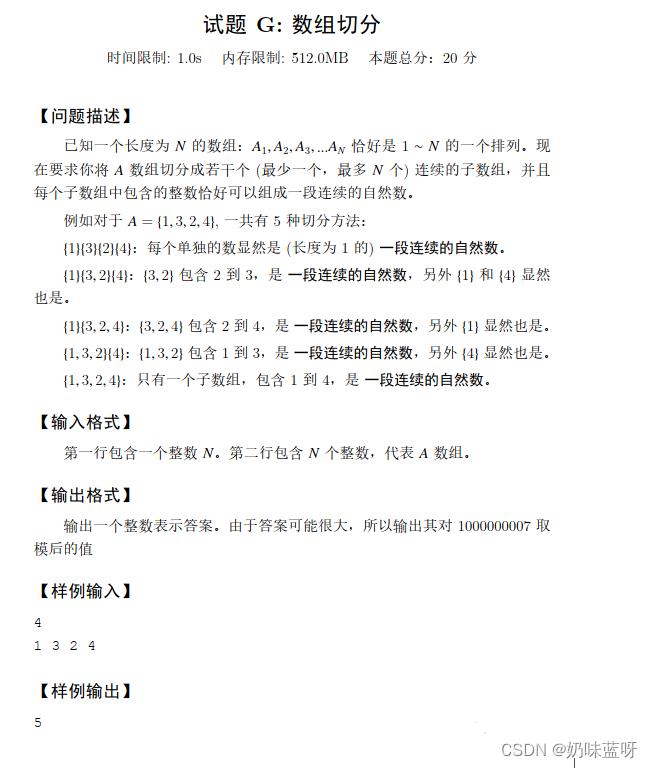

解析:
算法1 回溯算法
枚举所有分割点
回溯算法可以枚举所有情况,当每个切分的子数组都满足题目要求时,答案++,但时间复杂度较高,会tle
小技巧
问 : 如何判断区间[i,j]是否可以组成一段连续的自然数?
答 :只需 区间最大值 - 区间最小值 == j - i (区间长度)即可
import java.util.LinkedList;
import java.util.Scanner;
public class Main
static LinkedList<Integer> path = new LinkedList<>();
static int res = 0, mod = 1000000007;
public static void main(String[] args)
Scanner sc = new Scanner(System.in);
int n = sc.nextInt();
int[] a = new int[n];
for (int i = 0; i < n; i++) a[i] = sc.nextInt();
dfs(a, 0);
System.out.println(res % mod);
private static void dfs(int[] a, int startindex)
int n = a.length;
if (startindex == n)
res ++;
return;
for (int i = startindex; i < n; i++)
if (check(a, startindex, i))
path.add(i);
dfs(a, i + 1);
path.removeLast();
private static boolean check(int[] a, int l, int r)
int max = Integer.MIN_VALUE, min = Integer.MAX_VALUE;
for (int i = l; i <= r; i++)
if (a[i] > max) max = a[i];
if (a[i] < min) min = a[i];
return max - min == r - l;
算法2 DP(正解)
import java.util.Scanner;
public class Main
static int mod = 1000000007;
public static void main(String[] args)
// f[i]: 以a[i]结尾的切分合法数组的方法数量
Scanner sc = new Scanner(System.in);
int n = sc.nextInt();
int[] a = new int[n + 1];
for (int i = 1; i <= n; i++) a[i] = sc.nextInt();
int[] f = new int[n + 1];
f[0] = 1;
for (int i = 1; i <= n; i++)
int max = Integer.MIN_VALUE, min = Integer.MAX_VALUE;
for (int j = i; j > 0; j--)
max = Math.max(max, a[j]);
min = Math.min(min, a[j]);
//如果a[j, i]是一段连续的自然数,那么就有以a[i]结尾的合法切分合法数量+=以a[j - 1]结尾的合法切分数量
//即f[i] += f[j - 1]
if (max - min == i - j)
f[i] = (f[i] + f[j - 1]) % mod;
System.out.println(f[n]);
试题 H: 回忆迷宫
题目:
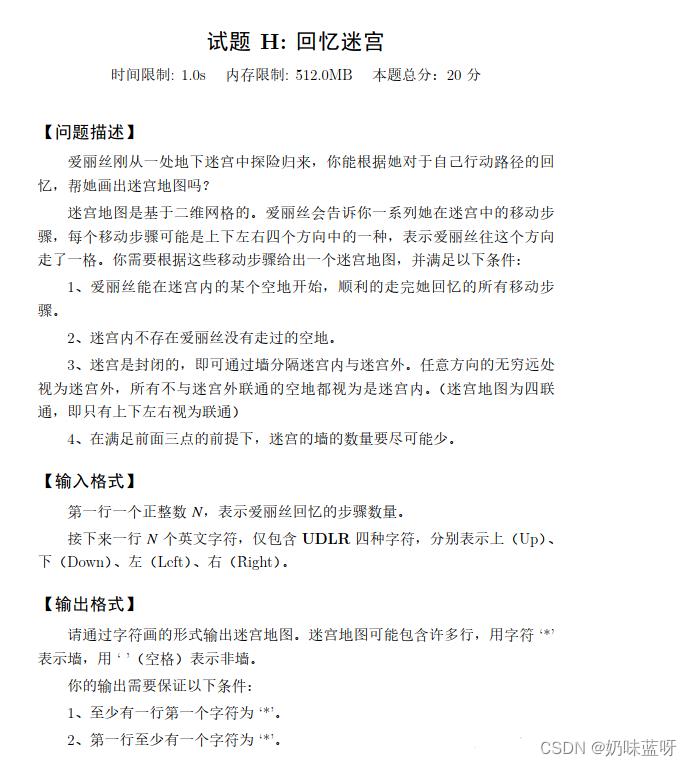
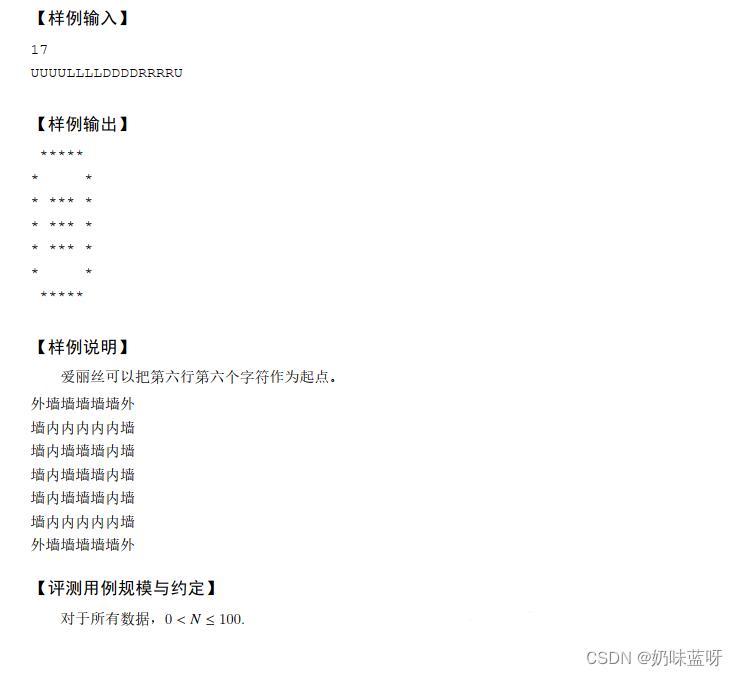
解析:
试题 I: 红绿灯
题目:
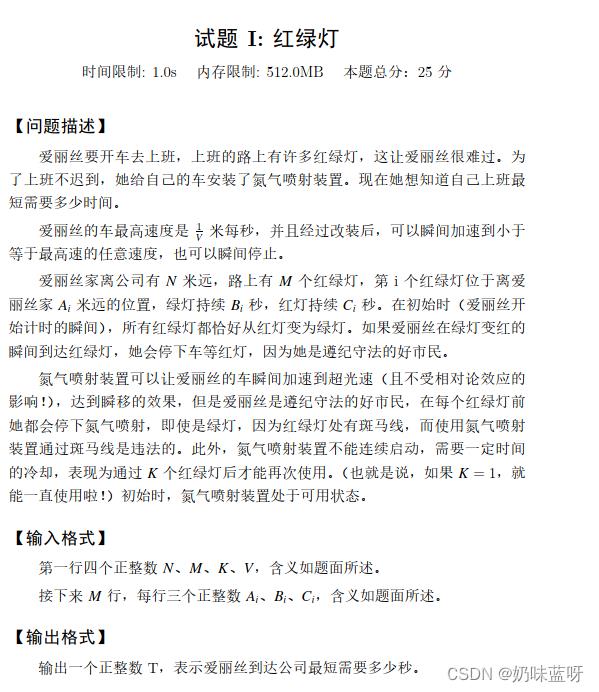
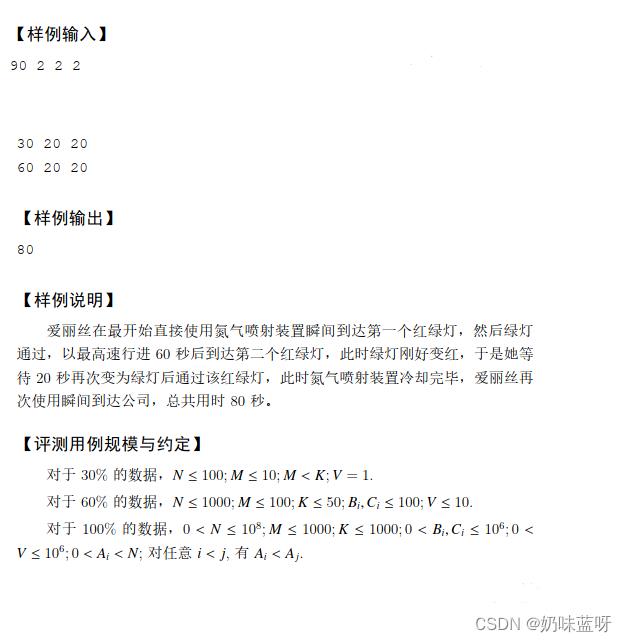
解析:
试题 J: 拉箱子
题目: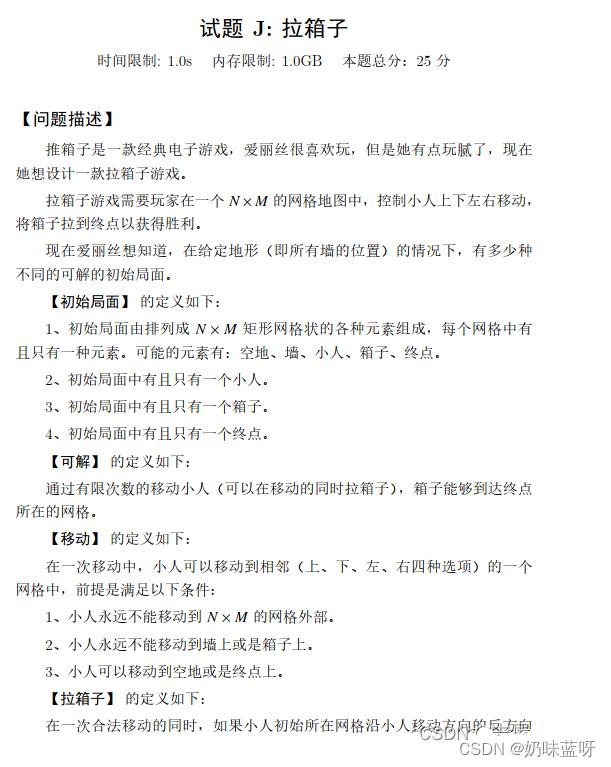
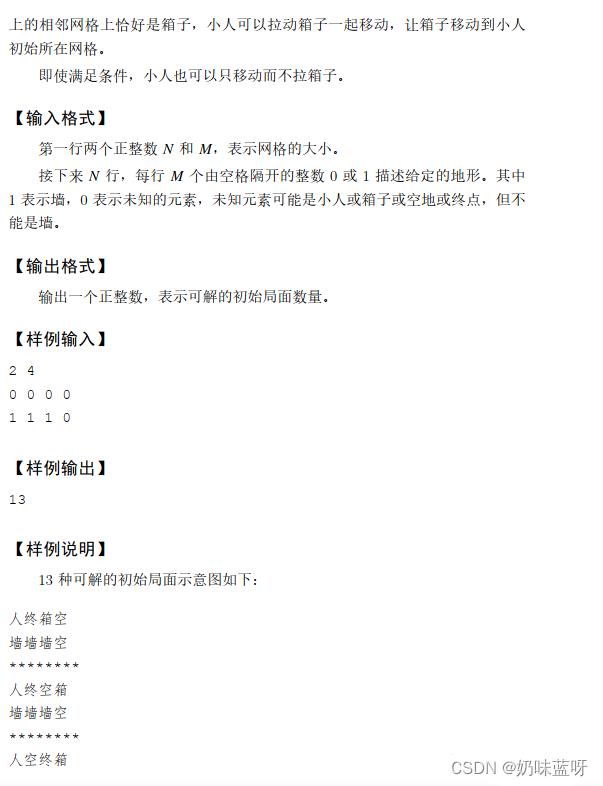

解析:
以上是关于蓝桥杯嵌入式第十三届客观题解析的主要内容,如果未能解决你的问题,请参考以下文章
《蓝桥杯真题》:2022单片机省赛第二场_客观题(第十三 / 13届第二场)
《蓝桥杯真题》:2022单片机省赛第二场_客观题(第十三 / 13届第二场)
《蓝桥杯真题》:2022单片机省赛第二场_客观题(第十三 / 13届第二场)